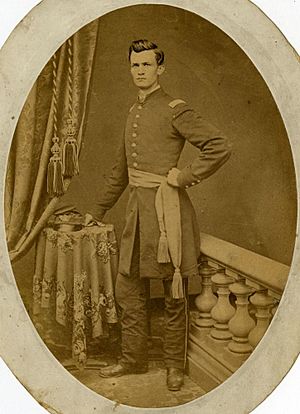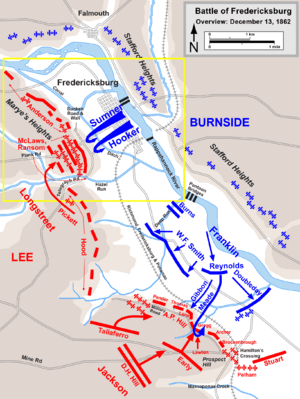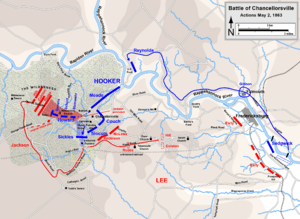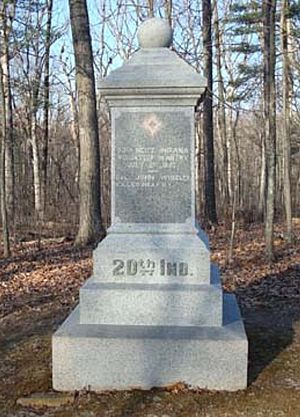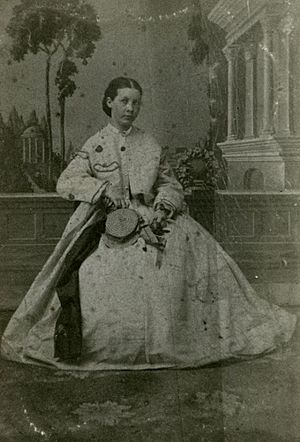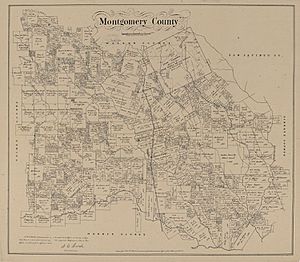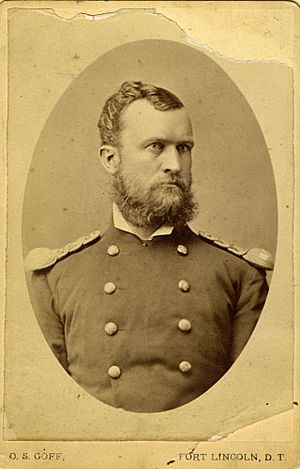Erasmus Corwin Gilbreath facts for kids
Quick facts for kids
Erasmus Corwin Gilbreath
|
|
|---|---|
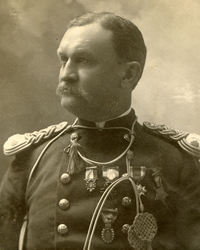
Last formal image taken of Maj. Gilbreath, 1897-1898
|
|
| Born | May 13, 1840 Guernsey County, Ohio |
| Died | August 22, 1898 (aged 58) Mayagüez, Puerto Rico |
| Buried | |
| Allegiance | |
| Service/ |
|
| Years of service | 1861-1898 |
| Rank | 1st Lieutenant Captain Major |
| Unit | 20th Indiana Volunteer Infantry Regiment 15th Infantry Regiment 11th Infantry Regiment |
| Battles/wars | American Civil War |
| Awards | Posthumously eligible for: |
| Spouse(s) | Susan Corse Gilbreath |
| Relations | William Sydnor Gilbreath (Son) Etta Moore Gilbreath(Daughter) Nan Lott Edwards(Daughter) Erasmus Gilbreath(Son) |
Erasmus Corwin Gilbreath (May 13, 1840 – August 22, 1898) was a major in the United States Army. He served for 37 years. He started as a first lieutenant in the 20th Indiana Volunteer Regiment.
Gilbreath fought in many important battles. These included the American Civil War, the American Indian Wars, and the Spanish–American War. He even saw the famous battle between the ironclad ships, the CSS Virginia and the USS Monitor. He also helped build Fort Custer. Gilbreath is buried in Arlington National Cemetery with his wife, Susan, and daughter, Etta.
Contents
- Early Life: A Young Man's Journey
- Joining the Army: The 20th Indiana Volunteers
- After the War: New Missions
- Spanish–American War: Final Service
Early Life: A Young Man's Journey
Erasmus Gilbreath was born on May 13, 1840. His birthplace was Guernsey County, Ohio. He was the oldest of three children. In the 1850s, his family moved to Indiana. They settled in Valparaiso.
In 1853, Erasmus's father died. This happened shortly after Erasmus finished school. He then had to help take care of his family. He studied law with Mark L. DeMott. DeMott later became a member of Congress. Gilbreath was close to becoming a lawyer.
Joining the Army: The 20th Indiana Volunteers
How the Regiment Was Formed
In April 1861, President Abraham Lincoln asked for volunteers. He needed 75,000 men for three months. Gilbreath first did not plan to join the army. But a visit from a friend changed his mind.
His friend, J. W. Lytle, had met a veteran named W.L. Brown. Brown wanted to create a rifle company. He asked Lytle to help recruit men. Brown promised Lytle a command position.
Lytle met with Gilbreath on June 5, 1861. The next day, they told people in Porter County about their plan. They planned a big meeting in Valparaiso on June 15. Gilbreath was amazed by the excitement. He wrote that "nearly everybody in the county came." They signed up 150 men in just one hour. This was 50 more than they needed.
The men then voted for their leaders. Lytle was elected Captain. Gilbreath became the 1st Lieutenant. This was a common way to choose leaders back then.
W.L. Brown became the colonel of the regiment. He set July 4, 1861, as the day to leave home. All companies met in Lafayette. Gilbreath said "almost every man, woman, and child was at Valparaiso." Fife and drum music played as they marched. The Sheriff and Blacksmith played the music. They were excited to join the army too.
The train went straight to Lafayette. There, the regiment fully gathered. The 20th Indiana Volunteer Regiment officially joined the U.S. Army. This happened on July 22, 1861. Gilbreath's company was called "I" company.
Getting Ready for War
The regiment left Lafayette on July 24. They went to Indianapolis for uniforms and gear. Officers bought their own uniforms and weapons. But enlisted men got their equipment from the government.
The troops hoped for new 1855 Springfield Rifles. But the government did not have enough. So, they got older 1795 Springfield Muskets. These had been updated to use percussion caps. The soldiers were very upset. They threw their weapons down in the street. The Governor promised new rifles soon.
The regiment then moved to Baltimore. Baltimore had recently seen anti-war riots. Many people there supported the South. Gilbreath's first job was to guard bridges. When they arrived, Colonel Brown ordered them to march with loaded muskets. He feared another riot.
From Baltimore, they went by steamship to Fort Monroe. They camped there until September 26. Gilbreath wrote little about this time. He only mentioned marching and drilling.
Action at Hatteras Inlet
On September 26, the regiment moved to Fort Hatteras. This fort was on Hatteras Island. It had been taken from the Confederates. They prepared to attack Confederate troops further up the inlet.
Gilbreath and 500 men landed at Chicamicomico Beach. This was on September 29, 1861. Their goal was to remove enemy forces from Roanoke Island. The commanding officer was in a hurry. So, the men landed without supplies or tents.
Supplies arrived on October 1. But the gunboat carrying them was attacked. Three Confederate gunboats attacked it. Hart and 47 men were captured. The Confederates took the supplies. More supplies arrived on October 3. The men were very happy to get them.
On October 4, Gilbreath saw a Confederate fleet. Nine ships were heading their way. They thought the fleet carried soldiers. These soldiers would cut them off from Fort Hatteras. So, Colonel Brown decided to retreat to Fort Hatteras.
That evening, they formed a skirmish line. This was to prevent an attack. Gilbreath was in charge of this. He worked hard to find water and cups. He used large shells from the beach as cups and shovels. The detachment reached Hatteras Lighthouse that night.
The next morning, they found a Georgia regiment had followed them. They were only a few miles from the lighthouse. The Union detachment marched back to Fort Hatteras. They were protected by the Frigate Minnesota. They learned later that the Confederate force had run aground. The Confederates had over 2,000 troops. The Union had only 500.
On November 3, new rifles arrived. On November 10, the regiment went back to Fort Monroe.
Witnessing the Ironclads Battle
In early 1862, Gilbreath was at Fort Monroe. He saw the Battle of Hampton Roads. This was where the CSS Virginia and USS Monitor fought. They battled for control of Hampton Roads. This is where rivers meet the Chesapeake Bay.
Gilbreath and his regiment helped in the battle. They helped wounded sailors get to shore. They also fired their small arms and artillery. Gilbreath described the battle in great detail. He noted the moon "seemed paler in the light of the burning Congress." He stayed with the 20th Indiana until May 10, 1862. Then, the regiment was ordered to take Norfolk. They did this with little fighting.
The Seven Days Battles
After the Battle of Seven Pines, the 20th Indiana joined the Army of the Potomac. It was led by General George B. McClellan. Gilbreath and his regiment fought in several parts of the Seven Days Battles.
Fighting at Oak Grove
Gilbreath's first land battle was on June 19. A small Confederate force attacked the 20th Indiana. This happened at 4:30 a.m. The regiment had only 3 casualties. The enemy had about 300 troops.
Heavier fighting began on June 25 at the Battle of Oak Grove. This was a Union attack on Confederate positions. It started around 8 a.m. The 20th Indiana was on the far left of the Union line.
General Joe Hooker's Division was on the right. They met strong resistance. But they pushed the Confederates back. General Heintzelman ordered artillery support. This stopped the immediate Confederate attack.
The fighting then moved to the Union left flank. This is where the 20th Indiana was. Gilbreath reported a sudden Confederate attack at 5:30 p.m. The 20th Indiana was getting ready to charge. The attack hit the 87th New York Regiment. This unit was next to the 20th Indiana. The 87th New York broke. This left the 20th Indiana's right side open.
Gilbreath said they fought hard. His regiment was pushed back a short distance. But they regrouped. They took back their positions. They stopped three more Confederate attacks. The regiment lost 125 men. This was almost a fifth of all casualties for their corps that day. Captain Lytle, Gilbreath's commander, was badly wounded.
The next day, the right side of the Army was attacked. This was north of the Chikahominy River. The 5th Corps broke and retreated. General McClellan decided to retreat to the James River.
Battles of Savage's Station and Glendale
The 20th Indiana saw the start of the attack on Savage's Station. Gilbreath did not say if they fought in the first part. But he wrote that the 20th Indiana was the rear guard. They stopped two Confederate attacks. These attacks aimed to destroy the retreating Union army. They also faced artillery fire. The regiment stayed until they were ordered to retreat. They moved towards Glendale that night. General Kearney praised Colonel Brown and his regiment.
The regiment arrived at Glendale the next day. They fought in the Battle of Glendale. Gilbreath's company stayed behind a log and rail wall. Gilbreath said this saved many lives. The regiment fought bravely. They had only 34 casualties.
The regiment was at the Battle of Malvern Hill. This was the last battle of the Seven Days Battles. But Gilbreath said his regiment was not directly involved.
Second Battle of Bull Run
On August 20, Gilbreath was promoted to captain. He took full command of I Company. This happened after Captain Lytle's death. Gilbreath wrote that Lytle's death was sad. He had been a family friend.
In the next few days, I Company camped near Rappahannock Station. On August 27, Gilbreath woke to artillery fire. He learned that Confederate forces had broken through. They were gathering at Manassas Junction. Gilbreath quickly moved his company. The regiment marched towards Manassas Junction. They arrived on August 28. They formed a skirmish line. But they did not find the Confederates. They followed them towards Centerville.
On August 29, the Division moved into position. They faced the Confederates. This was near where the Battle of Bull Run had been fought. The 20th Indiana was on the far right of the Union lines. Gilbreath said this kept them from the worst fighting. But they still lost many men. Most losses happened during their first advance. They moved towards the railroad. This served as a wall for the Confederates.
After taking this position, the regiment moved left. They hid in the bushes along the railroad. General Kearney gave this order. It was to help the Union center, which was breaking. Confederate forces charged. They passed the 20th Indiana without seeing them. Gilbreath's company then opened fire. They charged the enemy from the side. This surprise attack worked very well. It forced the Confederates to retreat.
Soon after, Colonel Brown was shot and killed. Major John Wheeler took command. The regiment stayed on the field all night. They did not fight directly the next day. Gilbreath saw a "wonderful and awe-inspiring picture of disaster." His regiment watched the Union left flank collapse. The regiment was ordered to retreat that evening. On August 31, they moved to help General Reno. But no help was given. General Kearney was killed while scouting ahead.
Battle of Fredericksburg
After the Second Battle of Bull Run, the 20th Indiana camped for a long time. They were on the southern side of the Potomac. This was because there were not enough troops ready to fight. The 20th briefly fought against a raid by Confederate General J.E.B. Stuart. Gilbreath noted that they only saw the enemy retreating.
While camping, Gilbreath was ordered to Washington. He was to gather wounded soldiers for his division. He spent about five days in Washington. He returned with about 350 men. Gilbreath had trouble controlling the men. They often wandered off.
The 20th Indiana started moving on October 26. This was part of General McClellan's plan. He wanted to meet the Confederate army in Virginia. During this march, General McClellan was removed from duty. President Lincoln felt he was too slow. Many soldiers were angry about this. Gilbreath did not state his own opinion. But he mentioned that McClellan was known for being "slow in his movements."
General Burnside took command. He planned to take Richmond. He wanted to cross the Rappahannock River at Fredericksburg. This would give him a better supply line. It would also force Lee into an open battle. But there were delays. Burnside's orders were also confusing. He could not build bridges until early December. By then, Lee had dug in his men on the heights behind the town.
The 20th Indiana camped north of Fredericksburg. They stayed there for the winter of 1862-1863. The regiment fought on December 13. They crossed the Rappahannock River. They charged Confederate positions on Marye's Heights. Gilbreath was wounded in the leg during this attack.
He suddenly felt his right leg "would not do its duty." He saw a bullet hole in his leg and fell. He lay on the ground from about 2 P.M. until 8 or 9 P.M. A sergeant from his company rescued him. While he was on the ground, Gilbreath saw many Union charges. They attacked the Confederate positions. Longstreet's veterans were behind a stone wall.
Gilbreath was taken to a house in Fredericksburg. It was a place for wounded soldiers. Wounded men were sent to hospitals across the river. But if a wound was too bad, surgeons would operate there. Surgeons thought Gilbreath's wound was too serious. They believed his right leg needed to be cut off.
By chance, a Confederate artillery shell hit the roof. In the confusion, Gilbreath got a surgeon's attention. The surgeon made sure Gilbreath went to the 3rd Corps hospital. He got proper treatment there. He was then sent to Washington to recover. Gilbreath spent four months in Washington. He returned to duty on April 1, 1863. He kept his leg, but he walked with a limp for the rest of his life.
Battle of Chancellorsville
When Gilbreath returned, General Joseph Hooker was in command. He had replaced General Burnside. Hooker planned to force Lee out of his trenches. He wanted an open fight. Hooker split his army into three parts. One part pretended to attack Fredericksburg. This kept Lee in his trenches. The other part went to Chancellorsville. This was to flank Lee's army.
The 3rd Corps, including the 20th Indiana, moved later. They arrived at Chancellorsville by 11 A.M. on May 1. They camped along a small stream. General Daniel Sickles, commander of the 3rd Corps, ordered the 20th Indiana to attack. He saw enemy movement near a railroad cut. The 20th Indiana advanced. They "captured nearly the whole of the 23rd Georgia Volunteer Regiment." The Georgian regiment was surprised and disorganized.
After advancing further, the 3rd Corps stopped. They were 3 miles ahead of the main army. General Jackson launched a surprise attack on the Union flank. This happened around 6 p.m. It broke the Union line. This cut off the 3rd Corps from the rest of the army. Gilbreath learned this at midnight.
Gilbreath gathered his company. The Corps tried to return north in the dark. They wanted to rejoin the main army. Gilbreath remembered being so close to Confederate lines. He could hear their roll call. The 3rd Corps linked up with the army on May 3. The 20th Indiana was positioned behind Chancellor House. They stayed there until the army retreated.
Battle of Gettysburg
On July 1, the 20th Indiana was ordered to Gettysburg. They arrived at 10:30 at night. They took positions on the right side of Cemetery Hill.
On July 2, General Daniel Sickles moved his III Corps. This included Gilbreath's regiment. They moved about half a mile in front of Cemetery Ridge. The 20th Indiana defended a spot called Devil's Den. Sickles moved his line without permission. He wanted slightly higher ground. This gave his troops an advantage. But it also created a weak point in the Union lines. By the time General Meade found out, it was too late to move them back.
The Confederate attack began at 4 P.M. It was led by General Longstreet. The fiercest fighting happened at the Peach Orchard, a wheat field, Little Round Top, and Devil's Den. Major John B. Wheeler, the commander of the 20th Indiana, was shot and killed. Gilbreath was the highest-ranking officer available. He took temporary command.
Gilbreath sent a messenger for more ammunition. An aide returned with orders. Gilbreath was told to hold his position. He should use all available ammunition. This included taking it from the wounded and dead. If ammunition ran out, he could retreat. The 20th Indiana, led by Gilbreath, held its position all day. They had 156 casualties.
On July 3, Gilbreath and his company saw Pickett's Charge. Gilbreath did not say his company fought directly. But he wrote a detailed account in his journal. Gilbreath was removed from temporary command. Lt. Col. Taylor was promoted to full colonel.
New York Draft Riot
On July 30, 1863, the 20th Indiana was called to New York. They were to help stop riots. These riots were about the new draft law. The regiment arrived on August 2. They used bayonets to clear Battery Park of rioters.
They camped in Battery Park that night. Gilbreath said the rioters were still violent. A picket line was set up to keep order. The next day, Gilbreath took four companies to Gramercy Park. They camped there and guarded an armory. The riots stopped. Gilbreath believed this was because so many soldiers were in New York. The regiment left New York three weeks later.
Siege of Petersburg and Leaving Service
Before the Siege of Petersburg, Gilbreath commanded 800 engineers. Their job was to build defensive walls for the siege. This happened during the night of June 21–22, 1864. The regiment took part in the siege until late July. Then, they were pulled back for rest.
In August, they made a fake attack towards Washington. The regiment marched towards Washington. They were then put on ships. They were taken closer to Confederate lines. In the First Battle of Deep Bottom, the 20th Indiana captured a hidden Confederate artillery battery. Captain Gilbreath did this. He tied a red handkerchief to a stick. It looked like a signal flag. The Confederate batteries thought it was a real signal. They opened fire, showing their position.
The regiment returned to Petersburg on August 18. During their last time at Petersburg, their commanding officer was killed. He was shot by a Confederate sharpshooter. Gilbreath was the most senior officer. He expected to be promoted to full command. But this did not happen. Instead, other regiments were combined into the 20th Indiana. This was to bring it back to full strength.
Most officers of the 20th Indiana were discharged. Only some support officers, like the Chaplain and Surgeon, stayed. Officers from the combined regiments took command. Gilbreath was among those discharged. His official discharge date was October 19, 1864.
After the War: New Missions
After leaving the 20th Indiana Volunteers, Gilbreath joined the army again. He became a Captain and Assistant Quartermaster on January 25, 1865. A month later, he joined "Hancock's Corps." This corps was made of Civil War veterans. He left his Quartermaster job on July 28, 1865. Then, he became a first lieutenant in the U.S. Regular Army. This was on February 23, 1866, in the 15th Infantry Regiment.
Two months later, Gilbreath married Susan Coale Corse. They married in Baltimore on April 23. His first son, William Sydnor Gilbreath, was born on January 24, 1867.
Serving in Mississippi
Gilbreath was assigned to C Company in Grenada, Mississippi. His job in Mississippi was to help with reconstruction. This meant choosing suitable men for local government jobs. He also acted as a judge for complaints from formerly enslaved people.
As part of his military service, Gilbreath worked for the Freedmen's Bureau. When formerly enslaved people complained about their former owners, Gilbreath often sided with them. He would require owners to pay money to their former slaves. Gilbreath said it was hard to make many Southerners understand that slaves were now free. He tried to set up a system where former owners gave a part of their crop to the freed people. This sometimes did not work well. White people controlled supplies. This could keep freed people in debt. But Gilbreath said this was not common. Many people tried to help the newly freed Black people.
Gilbreath also oversaw elections for local officials. He focused on stopping white people from changing Black votes.
Gilbreath also saw the start of the Ku Klux Klan in Mississippi. Their goal was to scare formerly enslaved people and workers of the Freedmen's Bureau. The Klan wore white hoods and planned attacks secretly. Gilbreath could do little to stop attacks until they had started.
Gilbreath reported that most Southerners were very hostile to the U.S. Army. Some people would ride by his home at night. They would fire pistols to scare him and his wife. Other times, riders would shoot at the U.S. flag near the camp. This showed their disloyalty. Gilbreath stopped this by ordering his men to shoot back. He was confident his troops would not hit anyone. The next time, his troops fired. The riders got scared and ran off. They were rounded up and brought back. Gilbreath lectured them. No more attacks on the flag happened while he was there.
Serving in Texas
Between 1866 and 1869, Gilbreath's regiment changed. It became the 24th Infantry Regiment. Then it became the 11th Infantry Regiment. The 11th Infantry was formed by combining the 24th and 29th Infantry. Gilbreath's unit, the 24th, moved to Texas. The 29th was already there. When Gilbreath arrived in Galveston, he was assigned to Company G. He was a 1st Lieutenant under Captain S.C. Green.
In early September 1869, Gilbreath was chosen for a special task. He was to help with reconstruction in Montgomery County. This was said to be one of the worst counties. Gilbreath had 30 men with him. When he arrived in Montgomery, he found a lawless place. He noted that someone reported a murder before he even set up camp. Churches had been closed for months. There were no schools. Everyone carried a knife or shotgun. Offenders were often "summarily punished by anybody."
Gilbreath began by issuing orders. No one could carry firearms except for hunting. Drinking and gambling places had to close by 10 P.M. on Saturday nights. They could not open until 6 A.M. on Monday. To his surprise, most people obeyed. Within a month, the county became much calmer.
Gilbreath had more trouble choosing civil officers. After the war, applicants could not have supported the Confederacy. They also had to promise loyalty to the U.S. No one wanted to take the oath. So, Gilbreath started a rumor. He said he would choose Black freedmen for the jobs. This quickly changed many minds. Many who had refused now agreed to take the oath. Gilbreath later learned that many civil offices had been passed down in families. People were hesitant to take over what they saw as a family position.
Gilbreath left Montgomery County in early 1870. His company was moved to Fort Griffin on the frontier. Gilbreath moved with his wife and two children. His youngest, Etta Moore Gilbreath, was born on March 9, 1870. At Fort Griffin, Gilbreath was the post quartermaster and commissary. He also handled relations with the nearby Tonkawa Indians. Gilbreath and his family left Fort Griffin in December 1872. They were ordered to New York City.
In New York, Gilbreath was sent to Evansville, Indiana. He and his family stayed there for 15 months. In December 1873, Gilbreath was promoted to captain. He was also transferred to Chicago. Gilbreath saw the Chicago Fire of 1874. His own house almost burned down.
Gilbreath was transferred back to Texas in fall 1874. He left Fort Concho. He took command of Company H, 11th Infantry. They were at a supply camp in Staked Plains, Texas. Their job was to supply troops and cowboys. They also guarded supplies from attack. Gilbreath personally led supply trains. This continued until early 1875. Then, Gilbreath was ordered to return to Fort Concho.
In 1875, Gilbreath was on sick leave in Baltimore. His leg wound from Fredericksburg was bothering him. An operation was needed. The surgeon at Fort Concho did not have the right equipment. So, Gilbreath went east for treatment. While he was recovering, his third child, Erasmus Gilbreath, was born. He had surgery in Baltimore. After 10 months, he returned to Fort Concho. He took command of his company again.
Service in the Dakotas
After the Battle of the Little Bighorn, Gilbreath and H Company went to the Dakota territory. This was on August 8, 1876. They camped at Yankton, South Dakota. They waited for the rest of the regiment. It was now led by Lieutenant Colonel George Buell. H Company was sent to Fort Yates. The Sioux tribe was very active there.
The 11th Infantry moved from the Dakotas to Montana. They were to build Fort Custer. During its construction, Gilbreath's fourth child, Nan Lott Gilbreath, was born. She was born in a tent at Terry's Landing. There was no doctor. Gilbreath got help from their cook. Soon after her birth, Gilbreath built a large blockhouse. This was to protect families and men. The Native Americans had become very aggressive.
Gilbreath stayed at Fort Custer until 1888. Then, his regiment was called back to New York.
Serving in Arizona
In 1891, the 11th Infantry was sent to Arizona. Their first post was Huachuca. Gilbreath did various jobs there. He even appeared as a witness at a court-martial. In March 1892, Gilbreath took companies F and H to San Carlos. This was the Apache Indian Agency. This posting lasted until July 1892. Then, Gilbreath was invited to command a recruiting post in Philadelphia.
Gilbreath stayed in Philadelphia for two years. He was then ordered to Whipple Barracks in Arizona.
Spanish–American War: Final Service
When the Spanish–American War began, the 11th Infantry moved. They went from Mobile, Alabama to Tampa, Florida. They were getting ready to invade Cuba. Around this time, Gilbreath heard from his wife. His daughter Nan had a serious infection. Gilbreath had little hope for her. She had been sick since February. But her health improved. She later married Mr. Oliver Edwards.
On his way to Florida, Gilbreath bought a hammock. He planned to use it in Cuba. But when he used it, a rope broke. The fall was very hard. Gilbreath said it "came near driving my spinal column clear out." This injury affected him through June. He noted it was hard to keep drilling.
The 11th Infantry left Florida on June 25. They sailed for Puerto Rico. On August 2, the regiment landed at Ponce, Puerto Rico. They arrived in Mayagüez on August 11. Gilbreath felt very ill. He remained sick and died on August 22, 1898. He died from a stroke. His wife, Susan Corse Gilbreath, received a monthly pension of $25.
|


